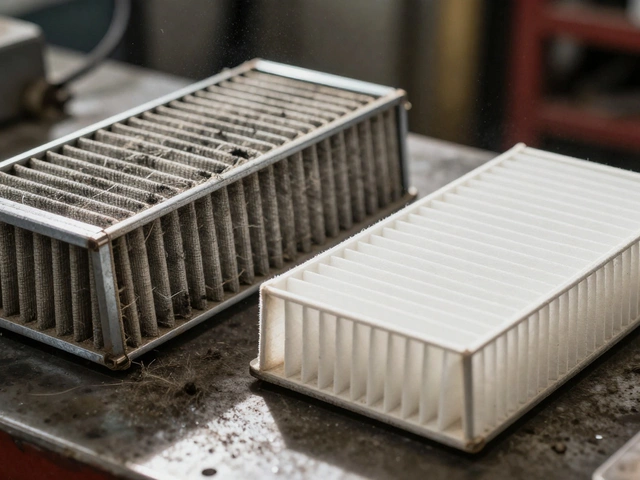There’s no magic number when it comes to exhaust pipe size, just hard choices that make a real difference. People love to brag about the beefiest pipes on their diesel pickups—like bigger always means better power, better sound, and street cred. But that’s not always the case. The right size depends on what you want from your truck or car, what kind of engine you’ve got, and honestly, how much drone you can live with.
So, what actually changes when you swap out a 4 inch for a 5 inch exhaust? You won't get an instant rocket ship, but you will notice some changes in backpressure, exhaust note, and sometimes even mileage. But don’t fall for hype—there are actually plenty of instances where bigger just means hassle, cost, and some annoyed neighbors.
If you’re eyeing a new exhaust because you want more power or a nastier growl, don’t just default to the largest pipe you can bolt on. Think about what kind of driving you do. Is it towing heavy loads up mountain grades? Or just flexing at the local meet? There’s a big difference, and the right answer saves you both money and headaches down the road.
- What Do Exhaust Pipe Sizes Actually Change?
- Performance Differences: 4 vs 5 Inch!
- Sound Profiles: Louder, Deeper, or Smoother?
- Fitment and Installation Tips
- Daily Driving vs Heavy Towing
- Picking the Right Size for Your Goals
What Do Exhaust Pipe Sizes Actually Change?
If you've ever compared a 4 inch exhaust to a 5 inch exhaust, you might wonder how much the actual size matters. It's not just about making your truck louder or looking cool—pipe diameter actually changes the way your exhaust system flows, which impacts performance, sound, and even engine health.
The main thing bigger pipes do? They reduce backpressure. Smaller pipes push exhaust gases out fast, but they can choke flow if you've got a tuned-up diesel or you’re running high boost. A bigger pipe moves gases with less resistance—especially important if you’re making a lot of horsepower.
- More flow can mean lower exhaust gas temperatures (EGTs), which is great if you tow heavy or tune aggressively.
- Bigger diameter pipes make it easier for exhaust gases to escape, especially at higher RPMs.
- If your setup is fairly stock, going huge in size won’t do much; there’s such a thing as too big, where you actually lose low-end grunt.
If you want some numbers, here’s a quick breakdown:
| Exhaust Size | Best For | Potential Gains |
|---|---|---|
| 4 inch | Stock to mildly tuned engines | Smoother flow, slight power increase, controlled sound |
| 5 inch | Heavily tuned or high-horsepower setups | Lower EGTs, deeper sound, less backpressure at high RPM |
But here’s a tip: Don’t just pick the biggest pipe thinking it's always better. Too little backpressure isn’t ideal for turbo spool-up, or for daily-driver street manners. You want the right balance so your ride doesn’t feel sluggish off the line. In the end, matching exhaust size to your engine’s needs is the ticket—not chasing whatever sounds wildest in the parking lot.
Performance Differences: 4 vs 5 Inch!
Right up front, the biggest changes with a 4 inch exhaust versus a 5 inch exhaust come down to how fast and easy your engine gets rid of spent gases. All exhaust pipes are there to move that hot air out, but bigger pipes mean less resistance—at least in theory. So you’d think more power, better throttle, and cooler engine temps, right? Well, it really depends on your build.
If you’re driving a stock or lightly tuned diesel, a 4 inch exhaust is honestly all most people need. It flows way better than stock, keeps backpressure low, and can support mild upgrades. Once you go with bigger turbos, injectors, and heavy custom tuning, a 5 inch exhaust starts to matter. The giant pipes let those built motors breathe much better when you’re really pushing them—think trucks making over 500 horsepower or hauling ridiculous loads.
| Exhaust Size | Best Fit For | Max Power Supported |
|---|---|---|
| 4 inch | Stock/tuned trucks, daily drivers | Up to ~500 HP |
| 5 inch | Big turbos, heavy towing, extreme builds | ~500 HP and above |
But here’s something most shops won’t tell you: with smaller turbo diesels, going too big on the exhaust actually cuts into low-end torque. The exhaust flow slows down, and you end up with turbo lag you didn’t have before. "The lowest restriction isn’t always the best for driveability or towing; exhaust velocity matters," says Nick Priegnitz at Calibrated Power Solutions.
A lot of customers assume ‘bigger exhaust equals more power,’ but a 5” system on a stock or near-stock truck can actually hurt turbo response and pull in the RPMs where you drive every day.
So, unless you’re building for competitions or maxing out your turbo setup, a 4 inch pipe gets the job done for most people—and it’ll usually cost less to buy and install. Die-hard performance junkies with monster builds will actually see a difference with a 5 inch exhaust, but everyone else might just be wasting money and dealing with extra drone for no reason.
- If your truck’s making under 500 HP, stick with 4 inch for better driveability.
- Big builds pushing serious air? Step up to a 5 inch only if you’re maxing out your current setup.
- Daily use and towing need exhaust velocity just as much as low backpressure, so don't go too big ‘just because’.
Bottom line: Match your exhaust system to your engine’s power and how you use your ride every day instead of chasing bragging rights.
Sound Profiles: Louder, Deeper, or Smoother?
Ask any gearhead about changing exhaust size and sound’s always part of the debate. If you’re coming from a stock system, even a 4 inch exhaust instantly makes things deeper and more aggressive. Bump that to a 5 inch exhaust, though, and it’s a whole new ballgame. Now you’re talking real volume—the kind that vibrates windows and maybe makes your spouse question your life choices.
So, what’s actually going on? Bigger diameter pipes let exhaust gases move with less restriction. That not only frees up sound but also changes the character of it. Here’s what you’ll usually notice:
- 4 inch exhaust: Gives you a throatier, noticeably deeper tone than stock. It’s punchy at idle and rumbles nicely when you give it gas, but it doesn’t take over every conversation on the highway. Good balance for daily drivers.
- 5 inch exhaust: Steps everything up. The note is lower, but also much louder. Some people love it; others complain about cabin drone, especially at cruising speeds. If you want to announce your presence a block away, this is your go-to.
Keep in mind, sound isn’t just about size. Muffler choice matters a lot. Some folks throw a straight pipe on a 5 inch system, which is brutally loud. If you stick with a quality performance muffler, you can tame some of that bark without killing the bassy growl.
Here’s a snapshot of what most people experience jumping between sizes:
| Exhaust Size | Loudness (1-10) | Tone | Cabin Drone |
|---|---|---|---|
| Stock | 2 | Mild, Civil | Low |
| 4 inch | 6 | Deep, Throaty | Low-Moderate |
| 5 inch | 9 | Very Deep, Boomy | Moderate-High |
If you’re on the fence, talk to folks who’ve already made the switch. Find a buddy with a setup similar to what you want, or poke around on truck forums for sound clips. Trust me, a 5 inch exhaust sounds awesome outside the truck, but after a two-hour highway trip, you might think differently. If you love that mean sound and don’t mind extra rumble inside, 5 inch is a blast. If you want it deep but liveable, 4 inch usually hits the sweet spot.

Fitment and Installation Tips
Going from a stock setup to a 4 inch exhaust is usually pretty straightforward for most pickups and diesels. There’s plenty of support for this size, so brackets, hangers, and clamps line up well on popular models. You might even find some systems that require almost zero cutting or welding. Still, double-check what’s included in the kit versus what your truck actually needs—some kits skip out on new gaskets or rubber hangers.
Jump up to a 5 inch exhaust and things get trickier. The pipe’s bulkier, which means routing it past axles, spare tires, or the fuel tank can get tight, especially on older Ram, Ford, and GM trucks. This size sometimes needs extra trimming or persuasion with a hammer if you’re doing it in your driveway. Occasionally, you may have to ditch or relocate the factory spare to make a 5 incher fit.
One thing people don’t always realize: a 5 inch system can hang lower than stock, so watch out for speed bumps or uneven job sites. If you tow heavy or drive off-road, ground clearance really matters. And if you install it yourself, wear gloves—fresh pipe edges are sharp.
Quick installation tips to make life easier:
- Test fit everything loose before you tighten the clamps. Small tweaks up front save hassle later.
- Grab a can of PB Blaster or WD-40—old exhaust bolts love to seize up.
- If you’re installing a 5 inch exhaust, check if you need longer exhaust hangers or custom brackets. Extra weight and vibration shake things loose over time.
- Recheck all clamps after your first long drive to make sure nothing’s coming apart.
If you’re in a rust-prone area, maybe drop a few bucks on stainless hardware. Nobody likes crawling under their truck in February to redo a rusty clamp.
| Problem | 4 Inch Exhaust | 5 Inch Exhaust |
|---|---|---|
| Stock Hanger Alignment | Usually good | May require mods |
| Ground Clearance | Normal | Reduced |
| Spare Tire Fit | Usually fits | Often tight/no room |
| Universal Part Fit | Wide support | Less variety |
If you’re on the fence, call your local shop and see what they see most often in your area. Nothing beats learning from the folks who have done it a hundred times already.
Daily Driving vs Heavy Towing
Daily drivers and heavy haulers live very different lives, and your choice between a 4 inch exhaust and a 5 inch exhaust should really come down to what kind of work you’re putting your rig through. A huge exhaust isn’t just for showing off at the taco stand—there are real situations where bigger (or not-so-big) makes sense.
If most of your time is spent cruising down highways, running errands, or commuting to work, a 4 inch exhaust is probably the sweet spot. It's usually less expensive, easier to install, and doesn’t drone as much inside the cab. Most trucks and diesel vehicles see little to no extra performance gain when moving from 4 to 5 inches unless they’re heavily tuned and pushing a lot of extra fuel and air. Plus, the 4 inch setup usually tucks up better under the truck, avoiding scraping and fitting headaches in crowded parking lots.
Now, if your truck is a workhorse—hauling trailers, equipment, or big campers on the regular—a 5 inch exhaust can help with reduced exhaust backpressure. That matters more when you’re pushing the turbo harder and keeping EGT (exhaust gas temperature) lower is important. Some diesel owners see a 150–200°F drop in EGT under heavy load after switching from 4 to 5 inch, which can make a real difference for engine longevity and keeping things cool on tough climbs.
Here’s a quick comparison for context:
| Feature | 4 Inch Exhaust | 5 Inch Exhaust |
|---|---|---|
| Best For | Daily Driving, Stock/Mild Tunes | Heavy Towing, Aggressive Tunes |
| Cab Noise | Quieter | Louder, More Drone |
| EGT Reduction | Moderate | Larger Drop |
| Installation | Easy, Tucks Neatly | Trickier, Clearance Issues |
To sum it up: daily city truck? Stick with 4 inch and save your ears. Constantly towing big loads or running a tuner? The 5 inch system is worth the hassle for the cooling alone. Whatever you do, don’t forget you might need to upgrade hangers or check local noise laws—exhaust tickets are a real mood killer.
Picking the Right Size for Your Goals
Nobody wants to waste cash on an upgrade that doesn’t actually help. When weighing a 4 inch exhaust against a 5 inch exhaust, your best option depends totally on what you—and your ride—actually need. It isn’t just a style choice; it’s about matching your engine and how you use your vehicle.
If you’re pushing a moderately tuned diesel, say with some light tuning or a mild programmer, a quality 4-inch system almost always handles airflow way better than stock. Guys love 5-inch pipes for bragging rights or raw sound, but unless you’re running high horsepower mods or towing fifth wheels every weekend, the actual gains above 4-inch are often slim. Here’s how it shakes out for most drivers:
- 4 inch exhaust: Great for daily drivers, mild tunes, and trucks that see a mix of highway and city. Keeps sound in check without a ton of drone, and usually fits without fighting for clearance.
- 5 inch exhaust: Makes sense if you’re all about max power (500+ HP), upgraded turbos, or heavy towing where every drop of EGT control counts. Expect more rumble and a bigger look, but also sometimes a tougher install.
If you’re still unsure, take a cue from the pros.
“Unless you’re running major power upgrades, you’ll rarely see real gains going over 4 inches. Most drivers notice more change in sound than in performance,” — Banks Power technical team
There are real-world numbers, too. Check this out:
| System Size | Average HP Supported | Noise | Best Use Case |
|---|---|---|---|
| 4 inch exhaust | Up to 500 HP | Moderate | Daily, light mod/tune |
| 5 inch exhaust | Up to 600+ HP | Louder/Deeper | Heavy tow, big turbo |
Installation matters, too. The 4-inch pipes tend to be a bolt-on deal for most trucks. The 5-inch systems sometimes need trimming or extra bracket work, especially if your truck isn’t lifted. If you want as little hassle as possible, 4-inch will almost always keep things easier and cheaper.
Quick tip: If your truck is mostly stock, you’ll see way more improvement by upgrading your intake or adding a mild tuner before you worry about those giant pipes. Save the 5-inch upgrade for when you’re chasing serious numbers—or just love the way it sounds rolling through town.




